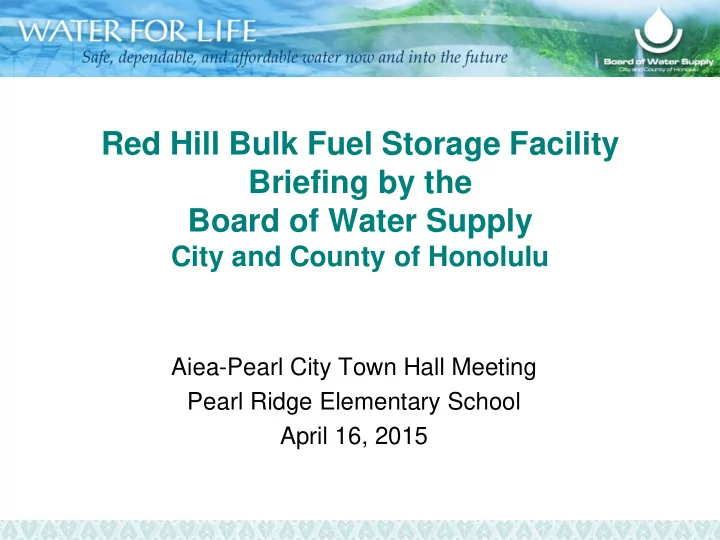

Red Hill Bulk Fuel Storage Facility Briefing by the Board of Water Supply City and County of Honolulu Aiea-Pearl City Town Hall Meeting Pearl Ridge Elementary School April 16, 2015
• Five BWS wells closest to Red Hill Facility site. • Irreplaceable Moanalua and Waimalu aquifer systems. • Five wells contribute 11.5% of the 140 MGD average daily production. • Halawa Shaft and Moanalua Wells contribute over 25% of the water serving Metro Honolulu system (Moanalua to Hawaii Kai).
BWS Well Testing • Halawa Shaft, Moanalua Wells, Aiea Wells, Aiea Gulch Wells and Halawa Wells • Quarterly testing since January 2014 • Testing parameters (> 240) • TPH (JP-5, JP-8, diesel, gasoline, motor oil) • Volatile and semi-volatile organic chemicals • Polyaromatic hydrocarbons • Petroleum degradates (TBA) • Metals (Pb, Cr, Cd, etc.) and naturally occurring chemicals (NO3, Cl, Br, SO4)
Navy Study and Fuel Record Findings • Navy commissioned studies • Petroleum hydrocarbons present in groundwater and soil beneath facility. • Warn of increasing facility age and potential for more releases both large and small. • Fuel releases • Occurred in the past (1947 – 1999) • Detail varies.
Underneath Red Hill Tanks • Basalt core samples taken from under each tank show petroleum stains. • 1998-2002 Investigations. Ref: Navy Phase II Site Characterization Report, Section 4, page 11, March 1999. (Related to Release ID 990051)
Monitor well locations
TPH in GW Underneath Red Hill Highest values recorded as of July 2014 Red Hill Shaft 58 ppb TPH diesel 19 ppb TPH gasoline RHMW02 0.099 ppb Naphthalene 6,300 ppb TPH diesel 0.018 ppb 2-Methyl naphthalene 3,903 ppb TPH gasoline CWRM 2253-03 0.04 ppb 1-Methyl naphthalene 0.86 ppb Acenapthalene 600 ppb TPH diesel 0.39 ppb Fluorene 28 ppb TPH gasoline 109 ppb 1-methylnaphthalene 0.16 ppb Naphthalene OWDFMW01 35 ppb 2-methylnaphthalene 0.9 ppb Lead 2,500 ppb TPH diesel 171 ppb Naphthalene 17 ppb TPH gasoline 0.58 ppb Ethyl benzene 0.09 ppb Naphthalene 1.06 ppb Xylenes 86 ppb Acetone 1.3 ppb Benzene 0.37 ppb Xylenes RHMW05 2,060 ppb TPH gasoline 0.17 ppb Naphthalene 0.28 ppb Lead RHMW01 RHMW03 1,500 ppb TPH diesel 330 ppb TPH diesel 15 ppb TPH gasoline 23 ppb TPH gasoline 5.6 ppb Naphthalene 0.32 ppb Naphthalene 10 ppb dissolved lead
Potential Contaminant Direction • 2010 Navy study identified northwest GW flow direction toward Halawa Shaft. • Hydrocarbon plume may be present. • Currently no monitor wells between Halawa Shaft and the Facility property line. • Additional monitor wells needed to define contaminant movement and direction beyond Facility property line.
BWS Approach to Red Hill • Continue quarterly testing of BWS wells near Red Hill • Examine the health significance of the low level petroleum chemicals in water • Conduct groundwater studies – understand impacts to the GW aquifer • Site and install monitor wells – collect more data • USGS modeling study on GW flow direction continues • Assess long-term impacts to BWS wells
BWS Approach to Red Hill – cont. • Inform and keep community updated • Support more resources and RH taskforce to continue study effects of fuel leak • Support Navy clean-up of existing contamination • Support regulations to cancel deferral of Red Hill tanks from the UST rules • Advocate initiatives to fortify the tanks and reduce risks to GW quality and quantity Preventing contamination is less costly than reacting after it occurs
Summary • Tests continue to show petroleum hydrocarbon chemicals present in GW and soil at Red Hill. • Mitigate petroleum hydrocarbons under Red Hill to protect Oahu’s GW and environment. • Potential future scenarios raise water capacity/ quality and economic concerns • Acting now protects the GW’s future – prevention vs. reaction
Questions/ Discussion
Recommend
More recommend